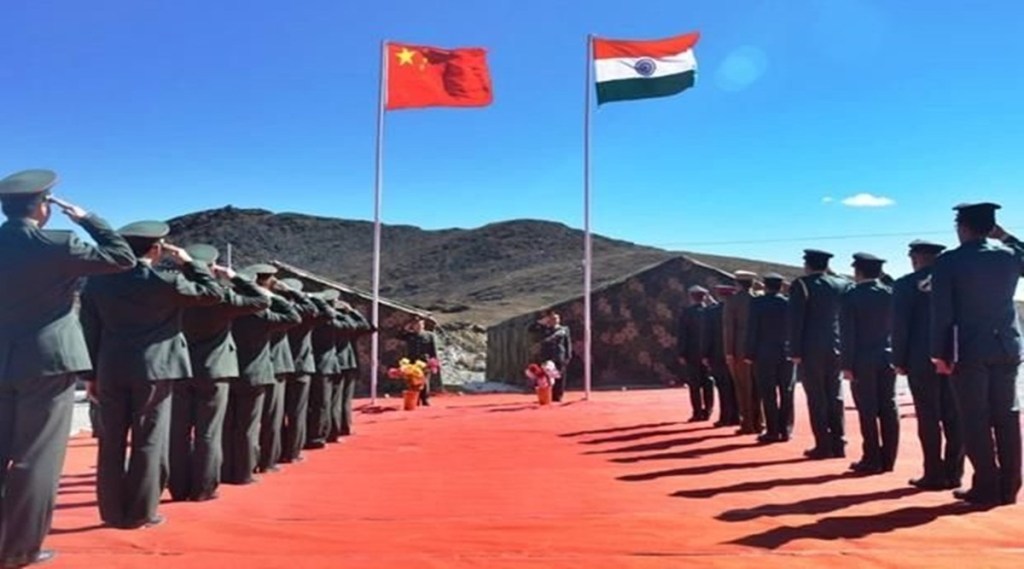By Lt Col Manoj K Channan (Veteran)
The standoff at the Line of Actual Control continues while the diplomatic and military interactions continue to be held to come to March 2020 positions. The foreign ministers of India and China Dr S Jaishankar and Mr Wang Yi met on the sidelines during the recently conducted G 20 summit. The deployment over two years has led to infrastructure development in the fragile Himalayan ecological region. The Chinese have constructed two bridges over the Pangong Tso Lake to enable quick deployment / side stepping of troops in case there is an escalation during the standoff.
The political leadership has been encouragingly focused on a military pull back; the actions on ground are at a large variance. The talks that were held at Chushul on the Indian side of the LAC would have focused on the Depsang Plains as well as Demchok.
It is in the interest of both countries to de-escalate as it has a severe cost on the logistics involved to keep the troops deployed, in this strategic barren land at high altitude. The turn around and relief of troops is impacted by the acclimatisation required to obviate health issues.
World focus remains on the Russian campaign in Ukraine, much has been happening in China. Covid and the floods have caused havoc in the population and the Chinese economy shrank by 2.6%.
President Xi Jinping methods to control the economy have come under scrutiny; Chinese oligarchs have spoken against it, a rare sight in the Communist nation. The tech sector had grown very powerful by 2020, with Alibaba founder Jack Ma openly criticizing CCP’s redundant financial regulations. Xi Jinping’s policies led to a technological massacre, and soon, Chinese tech companies found trillions of dollars of their wealth evaporating into thin air.
Xi Jinping has followed old Communist tactics of punishing the good and productive people. He exercised tight wealth control to stop the “disorderly spread of capital” and “private enterprises’ monopolistic and unfair competitive behaviour”. As a result, private companies have found it tough to sustain themselves. Laying off employees is rampant in China. Billions of dollars have now flown out of China.
Chinese investments and the destabilisation it is causing can be seen in the neighbourhood especially in Sri Lanka and Pakistan. Surprisingly having invested heavily in infrastructure in both the countries, China has been shy of supporting the erstwhile President in Sri Lanka. Pakistan foreign minister has met his counterpart in China with a possible aim of infusing fresh investments / loans to tide over their economic woes.
The US pullout from Afghanistan last year led to speculations that China may fill up the void, they have had dialogues but no substantial investments have been made so far. Afghanistan remains unstable, as hitherto fore.
In Nepal, China continues to play a dominant role and has Though the Nepal government and the Chinese Embassy in Kathmandu categorically deny having any boundary dispute, Nepali media has been occasionally reporting border friction between China and Nepal in Humla, Gorkha, Rasuwa and other districts.
The major bone of contention is the exact location of Pillar No. 57. After the two sides could not agree on the height of Mt Everest and the exact location of Pillar No. 57, the signing of the fourth protocol has been in limbo since 2011.
During the recently concluded virtual consultation meeting on border affairs, both sides agreed to activate the boundary mechanism, first agreed in 1963 while signing the first boundary protocol. The 1963 Joint Boundary Protocol has the provision of constituting three different mechanisms to deal with boundary issues — Joint Inspection Team, Joint Expert Group, and Joint Inspection Committee.
On the other hand with India, China has defaulted on all bilateral treaties.
Bangladesh has been resilient under the leadership of Prime Minister Sheikh Hasina, energy costs have impacted the economy as price rise has impacted the average consumer. Bangladesh’s current regime has been wary of the Chinese investments, in 2023 it remains to be seen which party forms the government.
Keeping the above scenarios in mind it will be prudent to assess that the Chinese are in no hurry to resolve issues with India. It will weigh its options carefully and exploit the weakness to its advantage. Recently the government of India gave sanctions to eighty Chinese companies to bring in FDI. The trade is increasing as well as India’s trade deficit with China. In my view, as the Chinese foreign minister has repeatedly been stating that focus on the larger areas of cooperation, the border disputes can be settled over time; may suit the Chinese, but in India it remains a matter of grave concern.
To offset the Chinese influence, India’s support to Quad, bilateral relations with the US and Russia remain a key factor. India has maintained an independent policy staying clear of the Western driven agenda or solely going with Russia.
The current Foreign Minister has been carving out India’s diplomatic role in a non-aligned manner to an extent. India’s relationships in the MENA region have been on an even keel.
While all the diplomatic initiatives seem to fructify, India needs to remain wary of the Chinese hunger for expansion along the LAC. The diminishing numbers of IAF squadrons, the modernisation program of the Indian Army and capacity building of the navy would need to be focused upon. The technological advantage has to be built up to cut down the manpower requirements. The terrain in India needs boots on the ground and any downsizing of the Indian Army should factor this in, with due diligence.
(The author is an Indian Army Veteran. Views expressed are personal and do not reflect the official position or policy of Financial Express Online. Reproducing this content without permission is prohibited).

